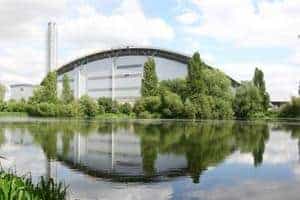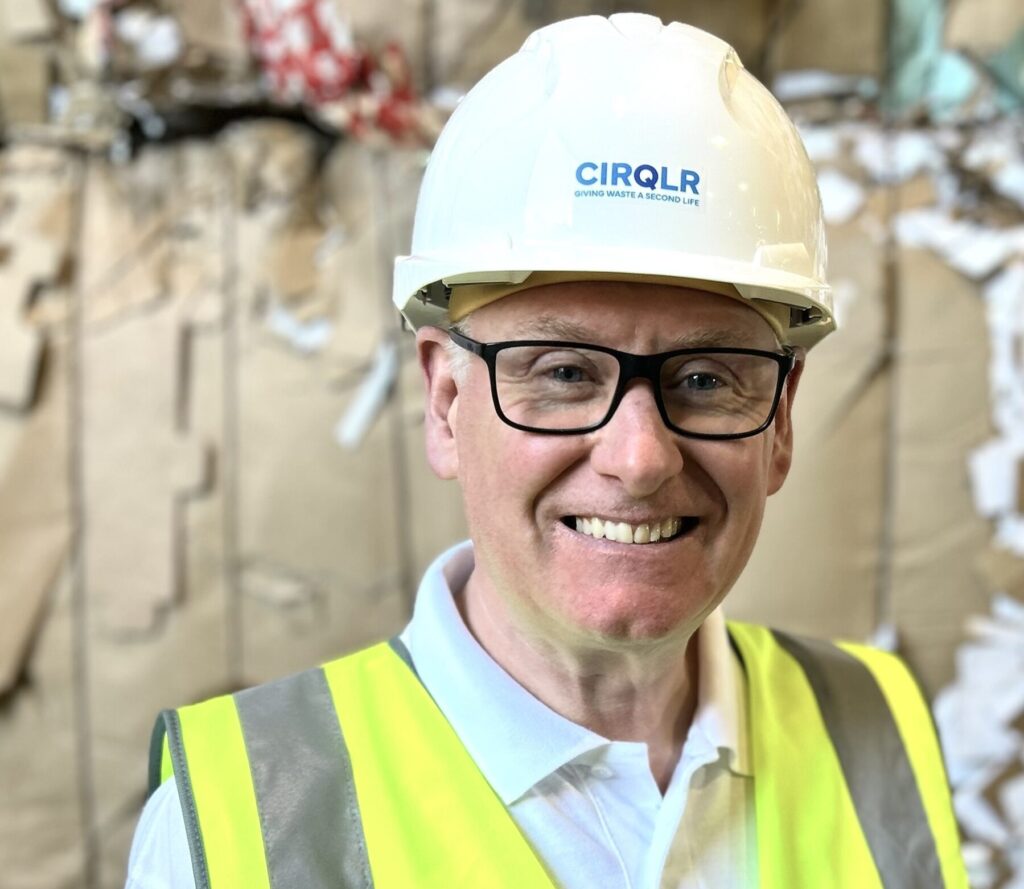The Thermal Treatment Working Group of the International Solid Waste Association (ISWA) held its most recent meeting in London. Study tours to the new Lakeside plant and to SELCHP were followed by an extensive networking meeting. The London meeting brought together more than 20 energy recovery experts from throughout Europe.
When the meeting was first planned it had been expected that the Lakeside plant would be fully operational. Sadly, when we visited the plant in September it was still a construction site and staff were trying to get over the latest in a series of problems that have progressively delayed both the plant's commissioning and now full opening.
On this occasion the problem occurred during the commissioning trials which started in June 2009. In August 2009 some non-conforming waste containing gas cylinders was delivered in defiance of the plant's tight specification for its waste acceptance criteria. Only municipal solid waste from collection rounds and some office and retail commercial wastes is contracted to be delivered into the Lakeside plant.
Unfortunately, the gas cylinders not only got into the Lakeside waste bunker but were picked up by the grab and fed through to one of the two boiler feeds to the furnace and exploded, causing damage which has had to be repaired. In addition, the whole bunker of waste had to be sorted to ensure that any other non-conforming wastes were eliminated. The plant will therefore not be fully operational until 2010, two years late.
The 400,000 tonne-a-year capacity Lakeside Energy from Waste Ltd plant is a 50:50 joint venture between the largest privately-owned waste management companies, Grundon, which is based in the Colnbrook area and Viridor, a subsidiary of the major water company Pennon, which is based in the south west of England.
The original £160 million budget for the plant's development will be exceeded by a considerable amount. When fully operational the plant's two 27tph grate furnaces, boilers and single generating unit will supply 32MW to the grid and will utilise a further 4MW within the plant.
Despite the fact that the site is only a few metres outside the Greater London boundary, only a limited amount of waste is going from London into the Lakeside plant. Waste is contracted to come from Wiltshire 120km to the west, Dorset 80km to the south of the plant and more locally from Slough and Berkshire. Clearly there is a need to rationalise waste movements within England in order to minimise the adverse impacts of the excessive and potentially unnecessary transport of waste.
Architecturally, the Lakeside plant complements Heathrow's terminal 5, located a mile to the south east of the Lakeside plant from where several of the overseas visitors had arrived earlier in the morning of their visit. We met initially at Lakeside's state of the art visitor centre which is built out over water into the “lake”, in reality a worked-out gravel pit but now looking superb thanks to long-term high quality restoration and the wonders of nature. Here, we were equipped with full safety equipment, on which the company places considerable emphasis, prior to our site visit.
The visitor centre was completed at the end of 2008 at a cost of £1 million and can accommodate a large number of people and with high quality audio-visual equipment. It also provides an excellent facility for meetings with local people.
The SELCHP facility in South East London is London's newest operational incineration plant and will remain so until 2012, when the Belvedere, Bexley 585,000 tonne-a-year capacity facility is due to become operational. Meanwhile SELCHP has now been serving various parts of south east and central London with waste treatment services for their residual waste for the past 15 years. Its waste incineration capacity is the same as the Lakeside plant in full operation at just over 400,000 tonnes-a-year
SELCHP has a very tightly constrained site, squeezed between two railway lines running out from London Bridge station. Despite that constraint, SELCHP did find the space to install a household waste and recycling facility only two years after the plant opened.
Emission Standards
The Working Group (WG) meeting, which was hosted by Waste Watch, the national waste reduction and minimisation organisation at their offices near Old Street, focused initially on the implications of the forthcoming Industrial Emissions Directive (IED), which will replace the IPPC Directive. The Swedes who hold the EU Presidency hope that they can see a second reading of the IED during their presidency.
There is concern among incinerator operators, irrespective of whether these are municipally or privately run, that it will be BREFs which will be used to set emissions standards and not the IED. The BREFs, because they use the technically optimum emissions abatement systems as their objective are always more onerous than the standards under the IPPC/IED.
Without looking at the overall technical, environmental and economic aspects the BREF standards could be regarded as unnecessarily onerous, especially when compared to those adopted, for example, for other air contaminant sources. The concern is real because a recently permitted plant in Lithuania has had its emission limits set by the BREF and not under the WID/IPPC Directive.
After lengthy debate over changing the name of the WG at a previous meeting – mainly between the proponents of Energy from Waste against the Waste to Energy supporters – the WG decided to change the name to the Working Group for Energy Recovery, thus removing the waste tag altogether.
Europe
The round table session of developments in Europe focused mainly on the issue of over-capacity of incineration plants in several countries. In Switzerland developing its energy from waste capacity has been part of a long-term plan. A plant opened in August 2009 has now raised the country's total incineration capacity to 105% of the total demand for burnable waste in Switzerland.
That figure includes not only MSW but also all burnable commercial and industrial waste generated in Switzerland. This is consistent with Switzerland's long-standing policy of self-containment and total waste treatment (zero waste?) with respect to its waste management and disposal. One key element is reducing its trans-boundary waste to a minimum, which is actually a move back from its 1970s policy of zero trans-boundary waste movement.
In the 1980s it was realised in Switzerland that there was a potential conflict between the national environmental policy on waste movement and the minimisation of environmental impacts of waste treatment within Switzerland.
Therefore there are wastes that are going to other European countries for treatment, such as shredder wastes from metal processing sites. In return, a number of mercury-bearing waste streams from several European countries are allowed into the treatment and recycling plant in Switzerland because it has sufficient capacity to deal with more than the mercury bearing wastes, such as batteries and dental amalgam generated in Switzerland itself.
For several years in southern Italy the problems of Naples and its waste accumulating in the streets have been making the headlines, not only within Italy but often Europe-wide. Now the export of waste to Austria and Germany from Naples by train for incineration appears to be over. The opening of Naples first three line 2,000tpd 340MW incineration plant is perhaps a sign of controversial Prime Minister Berlusconi's determination to sort out the waste management problems of the region.
For plastics packaging in Italy currently every item of plastics packaging that is separated by consumers will be collected and sorted but then nearly half of that plastics packaging by weight is sent to energy recovery plants.
These are mainly cement kilns which the plastics packaging compliance scheme uses, mainly because, as with the UK, there is insufficient MSW incineration capacity in Italy.
The most interesting energy recovery situation is not surprisingly in Germany where the energy from waste market is extremely competitive. Effectively now in Germany there are two markets for waste to energy options, with incinerators competing against electricity generating plants that are taking in segregated wastes and benefiting from the subsidies allowed for renewable energy sources, as is common throughout other EU MSs.
With the building of four million tonnes-a-year of incinerator capacity in the past five years Germany faces the position where there is overcapacity, exacerbated by the recession in reducing waste generation. The market price for waste going through to incinerators has declined throughout Germany but there is a regional component as well.
Therefore the lowest spot market prices are in the Eastern half of Germany with prices down to a low of €50 per tonne compared to the south where the lowest prices are around €80 per tonne, which is half the market price of five years ago.
However, the waste going through non-contracted systems is very limited and therefore there are not huge implications for the waste management system in Germany in the short term but the longer-term implications with competition with the electricity generation companies is very significant. Therefore, it is certain that there will be further implications, such as potential closure of capacity.
Denmark, like Switzerland, has sufficient incineration capacity for most of its burnable household, commercial and industrial waste. However PVC waste and residues are sent to landfill, while neighbouring Sweden is happy to put these types of waste through its incineration plants.
Denmark also puts its shredder residues to landfill, although it has a higher calorific value than MSW. There is full usage of the incineration capacity in Denmark with the recession having little impact on Denmark's European record of generating 700kg per capita per annum of MSW, a level which should not leave other EU States feeling complacent because Denmark's MSW statistics include a higher proportion of commercial and industrial waste than other EU MSs.
The Danes as part of their long-term environmental strategy have recently decided to increase the number of properties linked into district heating schemes in order to reduce the use of natural gas which provides a further incentive to energy recovery of all burnable wastes.
There are applications in place for a further one million tonnes of incineration capacity, mainly in Copenhagen with 700-800,000 tonnes. If and when they are built, these new incinerators will result in the phasing out of some of Denmark's older and smaller facilities.
The Danes, as part of their long-term environmental strategy, have recently decided to increase the number of properties linked into district heating schemes in order to reduce the use of natural gas
In Norway there is now a ban on the landfill of burnable waste and there are six new plants under construction as a result. Due to Norway's low and scattered population these plants, like the majority of Norway's existing plants are less than 60,000tpa capacity.
Waste goes from Norway to Sweden for disposal. Despite the existence of a waste incineration tax in Sweden it is still cheaper to incinerate waste in Sweden. However, the incineration tax in Sweden will be abandoned on September 1 2010.
In Finland two incineration plants are now in operation and a further five plants are under construction or advanced planning.
The Netherlands, like Germany, has increased its incinerator capacity, from six million tonnes to eight eight million over the past two years but meanwhile the MSW being presented for treatment has declined from 7.5m to 7m tonnes, due partly to the recession. However, thanks to the introduction of yellow bins for packaging waste from households, as in Germany, the amounts of waste going through to incineration will further reduce as more waste is recovered for recycling.
In France there is the same opposition to incineration as in the UK and therefore severe delay in the approval of projects, such as the St Omer plant which took one and a half years. Therefore in France there are lots of MBT plants being proposed and developed with the hope that the burnable fraction can be utilised in energy recovery plants.
In the UK section there was a focus on the recent publication of a Health Protection Agency (HPA) report, The Impact on Health of Emissions to Air from Municipal Waste Incinerators in early September which was of interest to other European colleagues. The conclusion of that report was that modern, well managed incinerators make only a small contribution to local concentrations of air pollutants. The evidence is that air pollution from incinerators makes up only a fraction of 1% of the country's particulate emissions. Industry and traffic account for more than 50% of total air emissions.
A 2004 study carried out by the Department for Environment, Food and Rural Affairs (Defra) reviewing air pollutants still remains the most extensive study in the UK. The HPA argued that since this time the evidence base has not changed significantly and therefore a further new study was unnecessary. In addition the Committee on Carcinogenicity of Chemicals in Food, Consumer Products and the Environment has reviewed recent data and concludes that the potential risk of cancer due to living near MSW incinerators is exceedingly low and probably not measurable.
Future
There will be a future meeting in Naples in 25-26 March 2010 with the opportunity to visit the new incineration plant. There will be a meeting in Lyons, France on 7-8 October 2010.
In addition there is the 6th ISWA Waste-to-Energy Beacon Conference to take place in 24-25 November 2009 in Malmo, Sweden. The keynote speaker will be Dr Caroline Jackson.










Subscribe for free